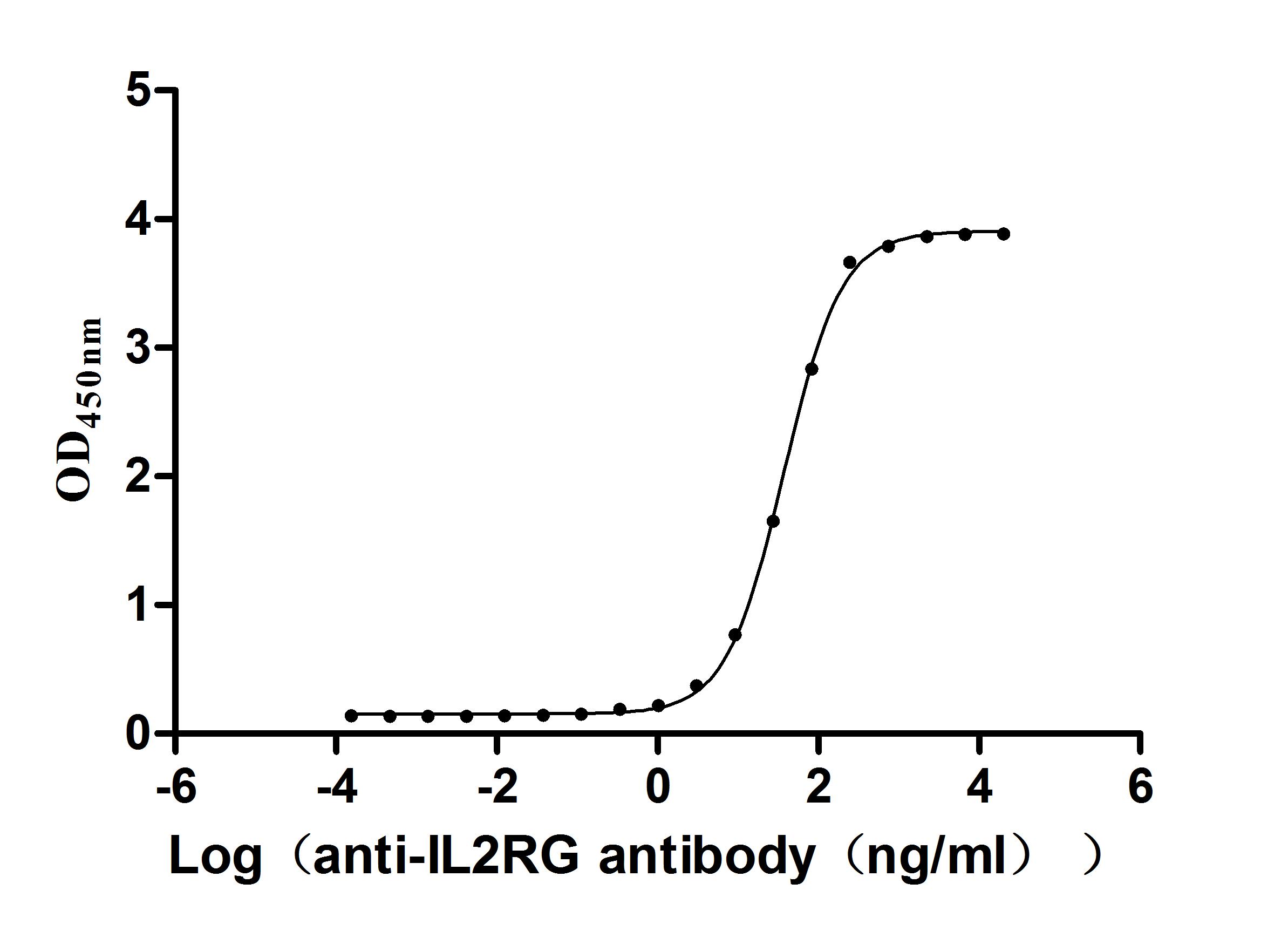The recombinant Macaca mulatta IL2RG protein is an active, high-purity product generated in mammalian cells to ensure proper structural integrity and post-translational modifications. It includes the partial of IL2RG, covering amino acids 23 to 255, and features a C-terminal 10xHis tag to support efficient purification and detection. This recombinant IL2RG protein demonstrates greater than 95% purity as confirmed by SDS-PAGE. Its functional performance is validated through ELISA, where immobilized IL2RG at 2 μg/mL specifically binds to the anti-IL2RG recombinant antibody (CSB-RA011651MA1HU), with an EC50 ranging from 33.73 to 41.04 ng/mL. These attributes make it a valuable tool for studying interleukin receptor signaling, antibody screening, and immunological assays involving the common gamma chain.
The IL2RG protein, known as the common gamma chain (γc), is a critical component of several interleukin receptors (IL-2, IL-4, IL-7, IL-9, IL-15, and IL-21) essential for lymphocyte development and function in mammals, including the rhesus macaque (Macaca mulatta). This protein's role is particularly pronounced in the immune system, where it facilitates the signaling processes necessary for the proliferation and differentiation of immune cells, including T and B lymphocytes [1][2].
Research has highlighted the relevance of IL2RG in response to therapeutic interventions and infectious diseases. Mutations in IL2RG lead to severe combined immunodeficiency (SCID) in various species, including macaques, as documented in models used for studying human diseases. This immunodeficiency is attributed to the absence of functional lymphocytes, underscoring the role of IL2RG in T and B cell maturation [2][3]. Rhesus macaques with functional IL2RG are thus used as an essential model to study not only basic immunology but also the efficacy of vaccines and immunotherapies for diseases like HIV [1][2].
Furthermore, a study by Maykel et al. illustrates the involvement of IL2RG in tumor biology and how its expression levels can affect both immune responses and tumor microenvironments in cancers such as breast cancer. This link demonstrates the importance of IL2RG beyond immunological contexts, positioning it as a potential biomarker for understanding tumor interactions with the host immune system [4][5].
Additionally, comprehensive profiling of receptor repertoires in rhesus macaques has shown that variations in IL2RG signaling can shape the functional responses of T and B cells during immune challenges. These insights provide significant data relevant for using macaques in translational research to understand human disease mechanisms, particularly in the context of HIV and cancer [6].
References:
[1] C. Manickam, S. Shah, J. Nohara, G. Ferrari, & R. Reeves. Monkeying around: using non-human primate models to study nk cell biology in hiv infections. Frontiers in Immunology, vol. 10, 2019. https://doi.org/10.3389/fimmu.2019.01124
[2] T. Pearson, L. Shultz, et al. Non-obese diabetic–recombination activating gene-1 (nod–rag 1 null) interleukin (il)-2 receptor common gamma chain (il 2 rγnull) null mice: a radioresistant model for human lymphohaematopoietic engraftment. Clinical & Experimental Immunology, vol. 154, no. 2, p. 270-284, 2008. https://doi.org/10.1111/j.1365-2249.2008.03753.x
[3] G. Finesso, E. Willis, et al. Spontaneous early-onset neurodegeneration in the brainstem and spinal cord of nsg, nog, and nxg mice. Veterinary Pathology, vol. 60, no. 3, p. 374-383, 2023. https://doi.org/10.1177/03009858231151403
[4] J. Maykel, J. Liu, H. Li, L. Shultz, D. Greiner, & J. Houghton. Nod-scidil2rg tm1wjl and nod-rag1 null il2rg tm1wjl : a model for stromal cell–tumor cell interaction for human colon cancer. Digestive Diseases and Sciences, vol. 59, no. 6, p. 1169-1179, 2014. https://doi.org/10.1007/s10620-014-3168-5
[5] X. Liu, G. Jin, et al. Digital gene expression profiling analysis and its application in the identification of genes associated with improved response to neoadjuvant chemotherapy in breast cancer. World Journal of Surgical Oncology, vol. 16, no. 1, 2018. https://doi.org/10.1186/s12957-018-1380-z
[6] L. Fu, X. Li, W. Zhang, et al. A comprehensive profiling of t- and b-lymphocyte receptor repertoires from a chinese-origin rhesus macaque by high-throughput sequencing. Plos One, vol. 12, no. 8, p. e0182733, 2017. https://doi.org/10.1371/journal.pone.0182733








